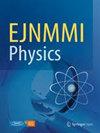利用多模态人工智能技术缩短儿科全身 PET/CT 成像扫描时间
IF 3
2区 医学
Q2 RADIOLOGY, NUCLEAR MEDICINE & MEDICAL IMAGING
引用次数: 0
摘要
本研究旨在利用多模态人工智能技术缩短小儿全身正电子发射计算机断层成像的扫描时间并提高图像质量。研究回顾性地纳入了270名在中山大学肿瘤防治中心使用uEXPLORER进行全身PET/CT扫描的儿科患者。18F-氟脱氧葡萄糖(18F-FDG)的剂量为3.7 MBq/kg,采集时间为600秒,通过截断列表模式数据获得短期扫描PET图像(6、15、30、60和150秒内采集)。以残差网络为基本结构开发了一个三维(3D)神经网络,将低剂量 CT 图像作为先验信息,按不同比例输入网络。通过多模态三维网络处理短期 PET 图像和低剂量 CT 图像,生成全长高剂量 PET 图像。非局部均值方法和没有融合 CT 信息的相同三维网络被用作参考方法。通过定量和定性分析评估了网络模型的性能。多模态人工智能技术能显著提高 PET 图像质量。当与先前的 CT 信息融合时,图像的解剖信息得到了增强,60 秒的扫描数据产生的图像质量可与全时数据相媲美。多模态人工智能技术能有效提高使用超短扫描时间获取的小儿全身 PET/CT 图像的质量。这有可能减少镇静剂的使用,增强监护人的信心,并降低运动伪影的概率。本文章由计算机程序翻译,如有差异,请以英文原文为准。
Reducing pediatric total-body PET/CT imaging scan time with multimodal artificial intelligence technology
This study aims to decrease the scan time and enhance image quality in pediatric total-body PET imaging by utilizing multimodal artificial intelligence techniques. A total of 270 pediatric patients who underwent total-body PET/CT scans with a uEXPLORER at the Sun Yat-sen University Cancer Center were retrospectively enrolled. 18F-fluorodeoxyglucose (18F-FDG) was administered at a dose of 3.7 MBq/kg with an acquisition time of 600 s. Short-term scan PET images (acquired within 6, 15, 30, 60 and 150 s) were obtained by truncating the list-mode data. A three-dimensional (3D) neural network was developed with a residual network as the basic structure, fusing low-dose CT images as prior information, which were fed to the network at different scales. The short-term PET images and low-dose CT images were processed by the multimodal 3D network to generate full-length, high-dose PET images. The nonlocal means method and the same 3D network without the fused CT information were used as reference methods. The performance of the network model was evaluated by quantitative and qualitative analyses. Multimodal artificial intelligence techniques can significantly improve PET image quality. When fused with prior CT information, the anatomical information of the images was enhanced, and 60 s of scan data produced images of quality comparable to that of the full-time data. Multimodal artificial intelligence techniques can effectively improve the quality of pediatric total-body PET/CT images acquired using ultrashort scan times. This has the potential to decrease the use of sedation, enhance guardian confidence, and reduce the probability of motion artifacts.
求助全文
通过发布文献求助,成功后即可免费获取论文全文。
去求助
来源期刊

EJNMMI Physics
Physics and Astronomy-Radiation
CiteScore
6.70
自引率
10.00%
发文量
78
审稿时长
13 weeks
期刊介绍:
EJNMMI Physics is an international platform for scientists, users and adopters of nuclear medicine with a particular interest in physics matters. As a companion journal to the European Journal of Nuclear Medicine and Molecular Imaging, this journal has a multi-disciplinary approach and welcomes original materials and studies with a focus on applied physics and mathematics as well as imaging systems engineering and prototyping in nuclear medicine. This includes physics-driven approaches or algorithms supported by physics that foster early clinical adoption of nuclear medicine imaging and therapy.
 求助内容:
求助内容: 应助结果提醒方式:
应助结果提醒方式:


